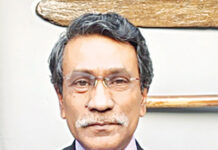University Education: One Size Fits All

There is this image which pops up here and there in many pedagogical conferences or academic sessions: a teacher deciding on a standardised test for a bunch of animals involving a wolf, a seal, a fish, a penguin, an elephant, a monkey and a bird. For a fair selection, the teacher declares that everyone must take the same exam of climbing a tree. Ignoring the possible danger of comparing our students with animals, one doesn’t need to be a genius to see the absurdity of such a testing system.
Each student has his or her own way of learning, still we expect our students to learn and perform at the same pace or style. When it comes to teaching, we have designed a one-size-fits-all strategy. We expect all our students to sit for two successive standardised tests to mark the end of their secondary and higher-secondary journey before joining the tertiary. And even before a teenager has come of age, we expect them to decide on which branch s/he wants to climb in one of the country’s 150 universities and hundreds of colleges.
According to the UGC Report 2017, of the 8.1 lakh students who passed HSC examination, only 49,695 students could find their places in the public universities, while 1.2 lakh joined the private system. There are roughly another 2 lakh students studying in degree colleges under the National University system. If the same trend prevails, half of the 9.8 lakh students who passed this year’s HSC examination would not enter the tertiary system. For them, the educational buck stops with the intermediate. Most of those who will continue with their academic journey are likely to opt for the public system. Given the low-cost and the supposed prestige factor, the attraction of top-tier public universities is understandable. However, the global outlook and the competitiveness of some of the private universities have begun to swing the pendulum in their favour. The top-ranked private universities believe in adding value to their incoming students, rather than expecting their students to know everything even before they have joined the university.
The purpose of an admission test in the public system is to eliminate the admission seekers. In so doing, a very cruel system has been devised where students are asked to “climb” up trees. Do I need to mention oftentimes such “climbing” was not taught at schools and colleges? The schools (in general) did not offer them a learning culture to help their students become critical thinkers with analytical skills and creative expressions. The failure of the mainstream schooling system, atrophied by the lack of good teachers and curricula, allowed a shadow support service to grow and thrive—the coaching! This parasitic system has feasted on the carcass of our schools, and grown powerful enough to brandish black money and to indulge in various spurious activities including question leakage.
The fact that our mainstream system is turning our students into parrots has not helped the cause either. The shadowy coaches (often moonlighters) pose as the ringmasters to supervise the move of our students to the next rung of their academic ladder. Soon after their HSC, students have to dive right into some guidebooks and resort to pre-university coaching centres. They do not even get the breathing space to think and decide what they really want to do in their life. One of my friends who did not make it to engineering school said something insightful that has stayed with me for more than three decades: “the only difference between someone who got into an engineering university or a medical college and me is that the person studied like a donkey after HSC, while I monkeyed around for three months.”
Despite its overgeneralisation, the statement contains some truth in it. My friend was smart enough to join DU and became a high-paid corporate official. He could have become an engineer or a doctor if only he had prepared himself for the rigorous tests that assessed memorising skills among others. Our admission system rarely credits those who are genuinely intelligent. Instead it usually sets questions of high difficulty as if the incoming students are expected to become an expert in the field even before joining a programme. And imagine, the same student has to master 4/5 different branches of knowledge to cross the admission hurdle.
Applicants are not tested for what they have learned in their 12 years at school. They are tested for their readiness for the drilling and grilling of academic life. Setting difficult questions in the name of elimination (which by default aids the coaching business) is just one side of the story. The other side involves the toils and trauma of these thousands of students who have to travel all over the country for the golden ticket of admission. One notable exception is the medical college testing system, which has adopted a centralised mechanism to avoid the admission circus.
I say “circus” because of the spectacle that the admission season entails. Of late, it has become a rather convenient time for campus agitation. Members of the public universities somehow find it timely to unfurl all the repressed rages or orchestrated frustrations against their administration during the admission tests. Probably they think that by offering this display of chaos before applicants and their guardians, they will prove their potency. Applicants are used as bargaining chips. While those in administration locate themselves on a moral high ground, saying, “Let’s not air our dirty laundry in front of our would-be students. We have no rights to upset the admission cycle as any disruption will have ripple effects on others.” On the other hand, the opportunist oppositions think that the admission season has exposed the underbelly of the administrative monster, and they must go for the kill and end the vices (pun added). Now why would a campus be divided into pro- and anti-administration camps is anybody’s guess! Shouldn’t educators be all pro-education? The answer, my friend, is blowing in the wind!
The general assumptions are: Teachers are using the admission system as a yearly occasion to make money. They prolong the process so that their billing hours rise on a pro-rata basis.
The absurdity, albeit obscenity, of the system is further intensified by the frequency of tests. Right after two successive public examinations within the span of two years, our students have to sit for admission tests in as many as 10-15 different institutions within two to three months. If you ask me, the entire testing and placement system needs a complete rehaul.
Do we really need the colonial testing system corresponding to matriculation and intermediate? Since we have moved to a four-year bachelor’s degree, why cannot we have a four-year high schooling system (class 9-12) with phased out exams like in the US? Even if we follow the UK model, why can’t we have a central placement service to administer the admission process such as UCAS?
The supply chain for the university must be streamlined if we want our higher education to be impactful. If the schools are given more space and resources to develop their students, our public universities will have to up their games to become the desired student destinations. There will be a healthy competition to get the best students. Presently, the public universities have the luxury of being lacklustre as their students are coming in steady numbers while their salaries are coming from the government exchequers. The jobs of government university teachers are considered secure unless they show signs of mental illness or moral turpitude.
The private education system is markedly different. Consequently, it is fast outperforming the public system partly because teachers here work under the swords of “philanthropic” investors or ruthless businessmen. They must perform or perish. Students also realise that education has become an investment of their time and money. No wonder, the private system treats its students as clients. It tries every trick in its repertoire to satisfy its customers. Crude as this last sentence may sound, this is the story of our higher education today. As someone who has travelled both public highway and private alleys of higher education, I can only loosely quote James Joyce, to conclude, that education in Bangladesh “is a nightmare from which I am trying to awake!”
Shamsad Mortuza is Pro-Vice Chancellor, University of Liberal Arts Bangladesh.









